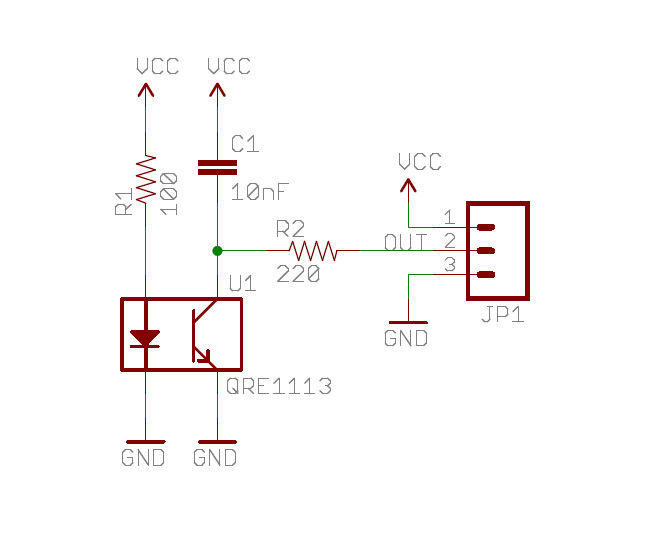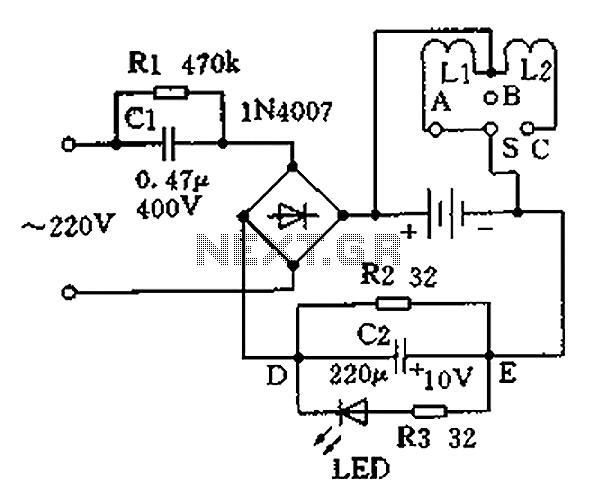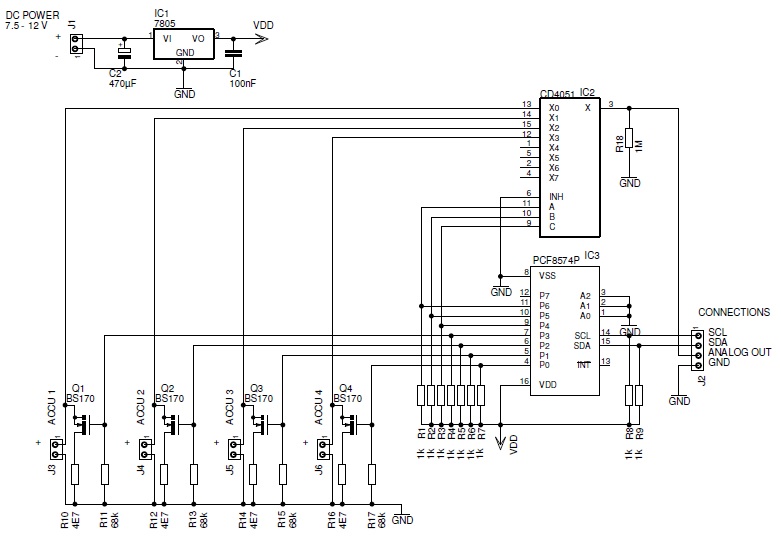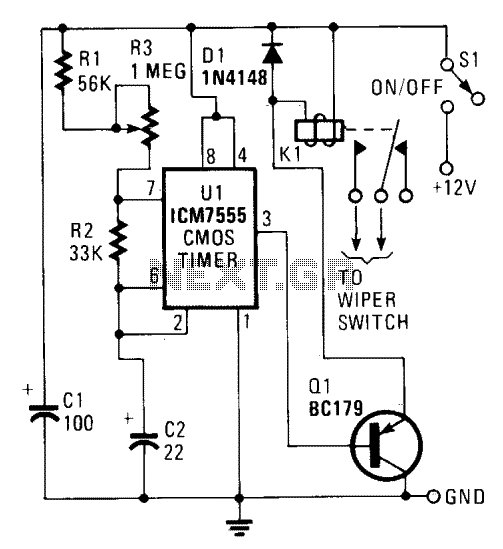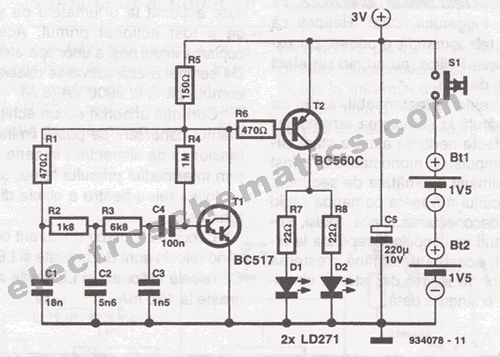
DC Motor Control Circuit
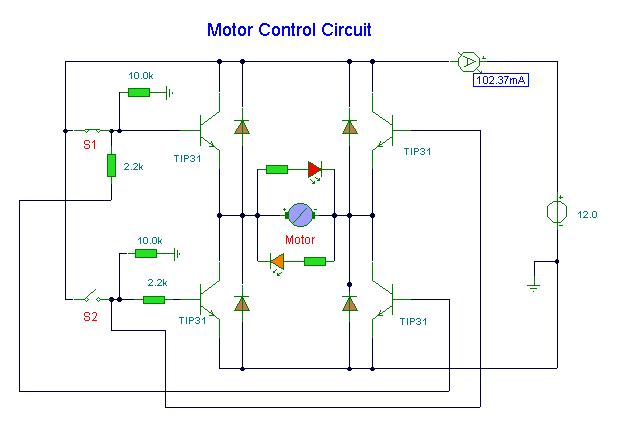
S1 and S2 are normally open, push-to-close, momentary switches. The diodes may be red or green and serve solely as indicators of direction. The TIP31 transistors may need to be adjusted based on the motor specifications. It is important to note that operating under load increases current draw. This circuit is designed to control a small motor used for opening and closing a pair of curtains. Unlike automatic systems, this setup allows for manual control over the amount of light entering a room. The four diodes surrounding the motor function as back EMF protection diodes, selected to match the motor's requirements. For a 12V motor drawing 1 amp under load, 1N4001 diodes are recommended.
This circuit utilizes two momentary push-button switches, S1 and S2, which are configured to control the direction of a small DC motor used for curtain operation. The switches are normally open, meaning they only complete the circuit when pressed. This design allows for manual control, providing the user with the flexibility to adjust the curtains to their desired position, thereby regulating light entry into a room.
The circuit incorporates TIP31 transistors which act as electronic switches that control the power to the motor. The selection of these transistors may need to be adjusted based on the motor's specifications, particularly in terms of current handling capacity. It is critical to recognize that when the motor operates under load, it draws more current; thus, ensuring that the transistors can handle the maximum current is essential for reliable operation.
Additionally, the circuit includes four diodes arranged around the motor to protect against back electromotive force (back EMF) generated when the motor is turned off. This back EMF can potentially damage other components in the circuit. The choice of diodes, such as the 1N4001 for a 12V motor drawing 1 amp, is based on the need to effectively handle the reverse voltage produced during motor operation.
Overall, this circuit provides an effective solution for controlling curtain movement with a manual interface, ensuring user flexibility while incorporating essential protective features to safeguard the components involved.Here, S1 and S2 are normally open, push to close, press button switches. The diodes can be red or green and are there only to indicate direction. You may need to alter the TIP31 transistors depending on the motor being used. Remember, running under load draws more current. This circuit was built to operate a small motor used for opening and closi ng a pair of curtains. As an advantage over automatic closing and opening systems, you have control of how much, or how little light to let into a room. The four diodes surriunding the motor, are back EMF diodes. They are chosen to suit the motor. For a 12V motor drawing 1amp under load, I use 1N4001 diodes. We aim to transmit more information by carrying articles. Please send us an E-mail to wanghuali@hqew. net within 15 days if we are involved in the problems of article content, copyright or other problems.
We will delete it soon. 🔗 External reference
This circuit utilizes two momentary push-button switches, S1 and S2, which are configured to control the direction of a small DC motor used for curtain operation. The switches are normally open, meaning they only complete the circuit when pressed. This design allows for manual control, providing the user with the flexibility to adjust the curtains to their desired position, thereby regulating light entry into a room.
The circuit incorporates TIP31 transistors which act as electronic switches that control the power to the motor. The selection of these transistors may need to be adjusted based on the motor's specifications, particularly in terms of current handling capacity. It is critical to recognize that when the motor operates under load, it draws more current; thus, ensuring that the transistors can handle the maximum current is essential for reliable operation.
Additionally, the circuit includes four diodes arranged around the motor to protect against back electromotive force (back EMF) generated when the motor is turned off. This back EMF can potentially damage other components in the circuit. The choice of diodes, such as the 1N4001 for a 12V motor drawing 1 amp, is based on the need to effectively handle the reverse voltage produced during motor operation.
Overall, this circuit provides an effective solution for controlling curtain movement with a manual interface, ensuring user flexibility while incorporating essential protective features to safeguard the components involved.Here, S1 and S2 are normally open, push to close, press button switches. The diodes can be red or green and are there only to indicate direction. You may need to alter the TIP31 transistors depending on the motor being used. Remember, running under load draws more current. This circuit was built to operate a small motor used for opening and closi ng a pair of curtains. As an advantage over automatic closing and opening systems, you have control of how much, or how little light to let into a room. The four diodes surriunding the motor, are back EMF diodes. They are chosen to suit the motor. For a 12V motor drawing 1amp under load, I use 1N4001 diodes. We aim to transmit more information by carrying articles. Please send us an E-mail to wanghuali@hqew. net within 15 days if we are involved in the problems of article content, copyright or other problems.
We will delete it soon. 🔗 External reference
Warning: include(partials/cookie-banner.php): Failed to open stream: Permission denied in /var/www/html/nextgr/view-circuit.php on line 713
Warning: include(): Failed opening 'partials/cookie-banner.php' for inclusion (include_path='.:/usr/share/php') in /var/www/html/nextgr/view-circuit.php on line 713
